| Revision as of 21:03, 3 January 2015 editIiKkEe (talk | contribs)Extended confirmed users13,522 edits rewrote Lead - for clarity, word economy, delete redundant info← Previous edit | Revision as of 21:24, 3 January 2015 edit undoIiKkEe (talk | contribs)Extended confirmed users13,522 edits Lead -delete sentence on what crops are not grown on plantations; correct one typoNext edit → | ||
| Line 5: | Line 5: | ||
| ] | ] | ||
| A '''plantation''' is a large piece of land where one crop is planted for wide-spread sale. These crops include fast-growing ]s (often ]s), cotton]], ], ], ], ], ] (e.g. ]s) and ] |
A '''plantation''' is a large piece of land where one crop is planted for wide-spread sale. These crops include fast-growing ]s (often ]s), cotton]], ], ], ], ], ] (e.g. ]s) and ]. The term "plantation" includes ]s are with the exception of bananas. ] policies and natural ] have sometimes contributed to determining where plantations were located. | ||
| Among the earliest examples of plantations were the ] of the ], which produced large quantities of wine and olive oil for export. Plantation agriculture grew rapidly with the increase in international trade and the development of a ] that followed the expansion of ]. Like every economic activity, it has changed over time. Earlier forms of plantation agriculture were associated with large disparities of wealth and income, foreign ownership and political influence, and exploitative social systems such as ] and ]. | Among the earliest examples of plantations were the ] of the ], which produced large quantities of wine and olive oil for export. Plantation agriculture grew rapidly with the increase in international trade and the development of a ] that followed the expansion of ]. Like every economic activity, it has changed over time. Earlier forms of plantation agriculture were associated with large disparities of wealth and income, foreign ownership and political influence, and exploitative social systems such as ] and ]. | ||
Revision as of 21:24, 3 January 2015
For other uses, see Plantation (disambiguation).| This article needs additional citations for verification. Please help improve this article by adding citations to reliable sources. Unsourced material may be challenged and removed. Find sources: "Plantation" – news · newspapers · books · scholar · JSTOR (May 2011) (Learn how and when to remove this message) |


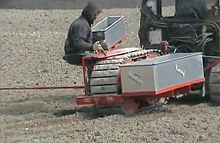
A plantation is a large piece of land where one crop is planted for wide-spread sale. These crops include fast-growing trees (often conifers), cotton]], coffee, tobacco, sugar cane, sisal, oil seeds (e.g. oil palms) and rubber trees. The term "plantation" includes Orchards are with the exception of bananas. Protectionist policies and natural comparative advantage have sometimes contributed to determining where plantations were located.
Among the earliest examples of plantations were the latifundia of the Roman Empire, which produced large quantities of wine and olive oil for export. Plantation agriculture grew rapidly with the increase in international trade and the development of a worldwide economy that followed the expansion of European colonial empires. Like every economic activity, it has changed over time. Earlier forms of plantation agriculture were associated with large disparities of wealth and income, foreign ownership and political influence, and exploitative social systems such as indentured labour and slavery.
Forestry
Industrial plantations
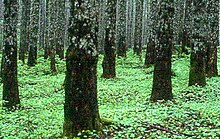


Industrial plantations are established to produce a high volume of wood in a short period of time for each society. Plantations are grown by state forestry authorities (for example, the Forestry Commission in Britain) and/or the paper and wood industries and other private landowners (such as Weyerhaeuser, Rayonier and Plum Creek Timber in the United States, Asia Pulp & Paper in Indonesia). Christmas trees are often grown on plantations as well. In southern and southeastern Asia, teak plantations have recently replaced the natural forest.
Industrial plantations are actively managed for the commercial production of forest products. Industrial plantations are usually large-scale. Individual blocks are usually even-aged and often consist of just one or two species. These species can be exotic or indigenous. The plants used for the plantation are often genetically altered for desired traits such as growth and resistance to pests and diseases in general and specific traits, for example in the case of timber species, volumic wood production and stem straightness. Forest genetic resources are the basis for genetic alteration. Selected individuals grown in seed orchards are a good source for seeds to develop adequate planting material.
Wood production on a tree plantation is generally higher than that of natural forests. While forests managed for wood production commonly yield between 1 and 3 cubic meters per hectare per year, plantations of fast-growing species commonly yield between 20 and 30 cubic meters or more per hectare annually; a Grand Fir plantation at Craigvinean in Scotland has a growth rate of 34 cubic meters per hectare per year (Aldhous & Low 1974), and Monterey Pine plantations in southern Australia can yield up to 40 cubic meters per hectare per year (Everard & Fourt 1974). In 2000, while plantations accounted for 5% of global forest, it is estimated that they supplied about 35% of the world's roundwood.
Growth cycle
- In the first year, the ground is prepared usually by the combination of burning, herbicide spraying, and/or cultivation and then saplings are planted by human crew or by machine. The saplings are usually obtained in bulk from industrial nurseries, which may specialize in selective breeding in order to produce fast growing disease- and pest-resistant strains.
- In the first few years until the canopy closes, the saplings are looked after, and may be dusted or sprayed with fertilizers or pesticides until established.
- After the canopy closes, with the tree crowns touching each other, the plantation is becoming dense and crowded, and tree growth is slowing due to competition. This stage is termed 'pole stage'. When competition becomes too intense (for pine trees, when the live crown is less than a third of the tree's total height), it is time to thin out the section. There are several methods for thinning, but where topography permits, the most popular is 'row-thinning', where every third or fourth or fifth row of trees is removed, usually with a harvester. Many trees are removed, leaving regular clear lanes through the section so that the remaining trees have room to expand again. The removed trees are delimbed, forwarded to the forest road, loaded onto trucks, and sent to a mill. A typical pole stage plantation tree is 7–30 cm in diameter at breast height (dbh). Such trees are sometimes not suitable for timber, but are used as pulp for paper and particleboard, and as chips for oriented strand board.
- As the trees grow and become dense and crowded again, the thinning process is repeated. Depending on growth rate and species, trees at this age may be large enough for timber milling; if not, they are again used as pulp and chips.
- Around year 10-60 the plantation is now mature and (in economic terms) is falling off the back side of its growth curve. That is to say, it is passing the point of maximum wood growth per hectare per year, and so is ready for the final harvest. All remaining trees are felled, delimbed, and taken to be processed.
- The ground is cleared, and the cycle is repeated.
Some plantation trees, such as pines and eucalyptus, can be at high risk of fire damage because their leaf oils and resins are flammable to the point of a tree being explosive under some conditions. Conversely, an afflicted plantation can in some cases be cleared of pest species cheaply through the use of a prescribed burn, which kills all lesser plants but does not significantly harm the mature trees.
Criticism of industrial plantations
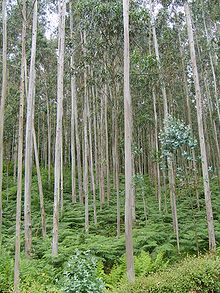
In contrast to a naturally regenerated forest, plantations are typically grown as even-aged monocultures, primarily for timber production.
- Plantations are usually near- or total monocultures. That is, the same species of tree is planted across a given area, whereas a natural forest would contain a far more diverse range of tree species.
- Plantations may include tree species that would not naturally occur in the area. They may include unconventional types such as hybrids, and genetically modified trees may be used sometime in the future. Since the primary interest in plantations is to produce wood or pulp, the types of trees found in plantations are those that are best-suited to industrial applications. For example, pine, spruce and eucalyptus are widely planted far beyond their natural range because of their fast growth rate, tolerance of rich or degraded agricultural land and potential to produce large volumes of raw material for industrial use.
- Plantations are always young forests in ecological terms. Typically, trees grown in plantations are harvested after 10 to 60 years, rarely up to 120 years. This means that the forests produced by plantations do not contain the type of growth, soil or wildlife typical of old-growth natural forest ecosystems. Most conspicuous is the absence of decaying dead wood, a crucial component of natural forest ecosystems.
In the 1970s, Brazil began to establish high-yield, intensively managed, short rotation plantations. These types of plantations are sometimes called fast-wood plantations or fiber farms and often managed on a short-rotation basis, as little as 5 to 15 years. They are becoming more widespread in South America, Asia and other areas. The environmental and social impacts of this type of plantation has caused them to become controversial. In Indonesia, for example, large multi-national pulp companies have harvested large areas of natural forest without regard for regeneration. From 1980 to 2000, about 50% of the 1.4 million hectares of pulpwood plantations in Indonesia have been established on what was formerly natural forest land.
The replacement of natural forest with tree plantations has also caused social problems. In some countries, again, notably Indonesia, conversions of natural forest are made with little regard for rights of the local people. Plantations established purely for the production of fiber provide a much narrower range of services than the original natural forest for the local people. India has sought to limit this damage by limiting the amount of land owned by one entity and, as a result, smaller plantations are owned by local farmers who then sell the wood to larger companies. Some large environmental organizations are critical of these high-yield plantations and are running an anti-plantation campaign, notably the Rainforest Action Network and Greenpeace.
Farm or home plantations
Farm or home plantations are typically established for the production of timber and fire wood for home use and sometimes for sale. Management may be less intensive than with Industrial plantations. In time, this type of plantation can become difficult to distinguish from naturally regenerated forest.
Teak and bamboo plantations in India have given good results and an alternative crop solution to farmers of central India, where conventional farming was popular. But due to rising input costs of farming many farmers have done teak and bamboo plantations which require very little water (only during first two years). Teak and bamboo have legal protection from theft. Bamboo, once planted, gives output for 50 years till flowering occurs. Teak requires 20 years to grow to full maturity and fetch returns.
Environmental plantations
These may be established for watershed or soil protection. They are established for erosion control, landslide stabilization and windbreaks. Such plantations are established to foster native species and promote forest regeneration on degraded lands as a tool of environmental restoration.
Ecological impact
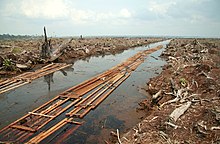
Probably the single most important factor a plantation has on the local environment is the site where the plantation is established. If natural forest is cleared for a planted forest then a reduction in biodiversity and loss of habitat will likely result. In some cases, their establishment may involve draining wetlands to replace mixed hardwoods that formerly predominated with pine species. If a plantation is established on abandoned agricultural land, or highly degraded land, it can result in an increase in both habitat and biodiversity. A planted forest can be profitably established on lands that will not support agriculture or suffer from lack of natural regeneration.
The tree species used in a plantation is also an important factor. Where non-native varieties or species are grown, few of the native fauna are adapted to exploit these and further biodiversity loss occurs. However, even non-native tree species may serve as corridors for wildlife and act as a buffer for native forest, reducing edge effect.
Once a plantation is established, how it is managed becomes the important environmental factor. The single most important factor of management is the rotation period. Plantations harvested on longer rotation periods (30 years or more) can provide similar benefits to a naturally regenerated forest managed for wood production, on a similar rotation. This is especially true if native species are used. In the case of exotic species, the habitat can be improved significantly if the impact is mitigated by measures such as leaving blocks of native species in the plantation, or retaining corridors of natural forest. In Brazil, similar measures are required by government regulations.
Plantations and natural forest loss
Many forestry experts claim that the establishment of plantations will reduce or eliminate the need to exploit natural forest for wood production. In principle this is true because due to the high productivity of plantations less land is needed. Many point to the example of New Zealand, where 19% of the forest area provides 99% of the supply of industrial round wood. It has been estimated that the world's demand for fiber could be met by just 5% of the world forest (Sedjo & Botkin 1997). However in practice, plantations are replacing natural forest, for example in Indonesia. According to the FAO, about 7% of the natural closed forest being lost in the tropics is land being converted to plantations. The remaining 93% of the loss is land being converted to agriculture and other uses. Worldwide, an estimated 15% of plantations in tropical countries are established on closed canopy natural forest.
In the Kyoto Protocol, there are proposals encouraging the use of plantations to reduce carbon dioxide levels (though this idea is being challenged by some groups on the grounds that the sequestered CO2 is eventually released after harvest).
Other types of plantation

Crops may be called plantation crops because of their association with a specific type of farming economy. Most of these involve a large landowner, raising crops with economic value rather than for subsistence, with a number of employees carrying out the work. Often it referred to crops newly introduced to a region. In past times it has been associated with slavery, indentured labour, and other economic models of high inequity. However, arable and dairy farming are both usually (but not always) excluded from such definitions. A comparable economic structure in antiquity was the latifundia that produced commercial quantities of olive oil or wine, for export. One plantation crop is bananas and there are others as well.
High value food crops
Plantings of a number of trees or shrubs grown for food or beverage, including tea, coffee, and cacao are generally called plantations. Some spice and high value crops grown from permanent perennial stock, such as black pepper, may also be so called. When the holding belongs to a single individual, that person may be called a planter.
Sugar
Main article: Sugar plantations in the CaribbeanSugar plantations were highly valued in the Caribbean by the British and French colonists in the 17th and 18th centuries and the use of sugar in Europe rose during this period. Sugarcane is still an important crop in Cuba. Sugar plantations also arose in countries such as Barbados and Cuba because of the natural endowments that they had. These natural endowments included soil that was conducive to growing sugar and a high marginal product of labour realized through the increasing number of slaves.
Rubber
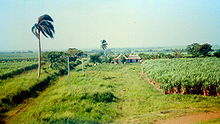
Plantings of para rubber, the tree Hevea brasiliensis, are usually called plantations.
Oil Palm
Oil palm agriculture is rapidly expanding across wet tropical regions, and is usually developed at plantation scale.
Orchards
Fruit orchards are sometimes considered to be plantations.
Arable crops
These include tobacco, sugarcane, pineapple, and cotton, especially in historical usage.
Before the rise of cotton in the American South, indigo and rice were also sometimes called plantation crops.

Fishing plantations in Newfoundland and Labrador
When Newfoundland was colonized by England in 1610, the original colonists were called "Planters" and their fishing rooms were known as "fishing plantations". These terms were used well into the 20th century.
The following three plantations are maintained by the Government of Newfoundland and Labrador as provincial heritage sites:
- Sea-Forest Plantation was a 17th-century fishing plantation established at Cuper's Cove (present-day Cupids) under a royal charter issued by King James I.
- Mockbeggar Plantation is an 18th-century fishing plantation at Bonavista.
- Pool Plantation a 17th-century fishing plantation maintained by Sir David Kirke and his heirs at Ferryland. The plantation was destroyed by French invaders in 1696.
Other fishing plantations:
- Bristol's Hope Plantation, a 17th-century fishing plantation established at Harbour Grace, created by the Bristol Society of Merchant-Adventurers.
- Benger Plantation, an 18th-century fishing plantation maintained by James Benger and his heirs at Ferryland. It was built on the site of Georgia plantation.
- Piggeon's Plantation, an 18th-century fishing plantation maintained by Ellias Piggeon at Ferryland.
Slavery, para-slavery and plantations
Main articles: Plantation economy and Slavery
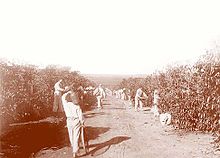
Slave labour extracted from forcibly transported Africans was used extensively to work on early plantations (such as cotton and sugar plantations) in the American colonies and the United States, throughout the Caribbean, the Americas and in European-occupied areas of Africa. Several notable historians and economists such as Eric Williams, Walter Rodney and Karl Marx contend that the global capitalist economy was largely founded on the creation and produce of thousands of slave labour camps based in colonial plantations exploiting tens of millions of abducted Africans.
In modern times, the low wages typically paid to plantation workers are the basis of plantation profitability in some areas. Sugarcane plantations in the Caribbean and Brazil, worked by slave labour, were also examples of the plantation system.
In more recent times, overt slavery has been replaced by "para-slavery" or slavery-in-kind, including the sharecropping system. At its most extreme, workers are in "debt bondage": they must work to pay off a debt at such punitive interest rates that it may never be paid off. Others work unreasonably long hours and are paid subsistence wages that (in practice) may only be spent in the company store.
In Brazil, a sugarcane plantation was termed an engenho ("engine"), and the 17th-century English usage for organized colonial production was "factory". Such colonial social and economic structures are discussed at Plantation economy. Sugar workers on plantations in Cuba and elsewhere in the Caribbean lived in company towns known as Bateys.
Plantations in the antebellum American South
Main articles: Plantations in the American South and Plantation complexes in the Southeastern United StatesIn the American South, antebellum plantations were centered on a "plantation house", the residence of the owner, where important business was conducted. Slavery and plantations had different characteristics in different regions of the South. As the Upper South of the Chesapeake Bay Colony developed first, historians of the antebellum South defined planters as those who held 20 or more slaves. Major planters held many more, especially in the Deep South as it developed. The majority of slaveholders held 10 or fewer slaves, often just a few to labour domestically. By the late 18th century, most planters in the Upper South had switched from exclusive tobacco cultivation to mixed crop production, both because tobacco had exhausted the soil and because of changing markets. The shift away from tobacco meant they had slaves in excess of the number needed for labour, and they began to sell them in the internal slave trade.
There was a variety of domestic architecture on plantations. The largest and wealthiest planter families, for instance, those with estates fronting on the James River in Virginia, constructed mansions in brick and Georgian style, e.g. Shirley Plantation. Common or smaller planters in the late 18th and 19th century had more modest wood frame buildings, such as Southall Plantation in Charles City County.

In the Low Country of South Carolina, by contrast, even before the American Revolution, planters holding large rice and cotton plantations in South Carolina typically owned hundreds of slaves. In Charleston and Savannah, the elite also held numerous slaves to work as household servants. The 19th-century development of the Deep South for cotton cultivation depended on large plantations with much more acreage than was typical of the Chesapeake Bay area, and for labour, planters held hundreds of slaves.
Until December 1865 slavery was legal in parts of the United States. Most slaves were employed in agriculture, and "planter" was a term commonly used to describe a farmer with many slaves.
The term "planter" has no universally accepted definition but academic historians have defined it to identify the elite class, "a landowning farmer of substantial means." In the "Black Belt" counties of Alabama and Mississippi, the terms “"planter" and "farmer" were often synonymous. Robert Fogel and Stanley Engerman define large planters as owning over 50 slaves, and medium planters as owning between 16 and 50 slaves. In his study of Black Belt counties in Alabama, Jonathan Wiener defines planters by ownership of real property, rather than of slaves. A planter, for Wiener, owned at least $10,000 worth of real estate in 1850 and $32,000 worth in 1860, equivalent to about the top 8 percent of landowners. In his study of southwest Georgia, Lee Formwalt also defines planters in size of land holdings rather than slaves. Formwalt's planters are in the top 4.5 percent of landowners, translating into real estate worth $6,000 or more in 1850, $24,000 or more in 1860, and $11,000 or more in 1870. In his study of Harrison County, Texas, Randolph B. Campbell classifies large planters as owners of 20 slaves, and small planters as owners of between ten and 19 slaves. In Chicot and Phillips Counties, Arkansas, Carl H. Moneyhon defines large planters as owners of twenty or more slaves, and six hundred or more acres.
See also
References
- Notes
- "Forest loss". United Nations System-wide Earthwatch. United Nations Environment Programme. Archived from the original on January 6, 2010. Retrieved October 27, 2011.
- Overbeek W. (2012). "An overview of industrial tree plantation conflicts in the global South. Conflicts, trends, and resistance struggles" (PDF). EJOLT. 3: 84.
- ^ Peter Kolchin, American Slavery 1619–1877, New York: Hill and Wang, 1993, xiii
- Oakes, Ruling Race, 52.
- Fogel, Robert William; Engerman, Stanley L. (1974). Time on the Cross: The Economics of American Negro Slavery. Boston: Little, Brown. OCLC 311437227.
- Wiener, Jonathan M. (Autumn 1976). "Planter Persistence and Social Change: Alabama, 1850–1870". Journal of Interdisciplinary History. 7 (2): 235–60. JSTOR 202735.
- Formwalt, Lee W. (October 1981). "Antebellum Planter Persistence: Southwest Georgia—A Case Study". Plantation Society in the Americas. 1 (3): 410–29. ISSN 0192-5059. OCLC 571605035.
- Campbell, Randolph B (May 1982). "Population Persistence and Social Change in Nineteenth-Century Texas: Harrison County, 1850–1880". Journal of Southern History. 48 (2): 185–204. JSTOR 2207106.
- Moneyhon, Carl H. (1992). "The Impact of the Civil War in Arkansas: The Mississippi River Plantation Counties". Arkansas Historical Quarterly. 51 (2): 105–18. JSTOR 40025847.
- Bibliography
- Aldhous, J. R. & Low, A. J. (1974). The potential of Western Hemlock, Western Red Cedar, Grand Fir and Noble Fir in Britain. Forestry Commission Bulletin 49.
- Everard, J. E. & Fourt, D. F. (1974). Monterey Pine and Bishop Pine as plantation trees in southern Britain. Quarterly Journal of Forestry 68: 111-125.
- Savill, P. Evans, J. Auclair, D. Falk, J. (1997). Plantation Silviculture in Europe. Oxford University Press. Oxford. ISBN 0-19-854909-1
- Sedjo, R. A. & Botkin, D. (1997). Using forest plantations to spare natural forests. Environment 39 (10): 15-20, 30.hu
- Thompson, Edgar Tristram. The Plantation edited by Sidney Mintz and George Baca (University of South Carolina Press; 2011) 176 pages; 1933 dissertation
- Virts, Nancy, “Change in the Plantation System: American South, 1910–1945,” Explorations in Economic History, 43 (Jan. 2006), 153–76.
External links
- Trends in Round wood production
- Earth Repair Network Advocates plantation forestry.
- "Pulping the South" Criticism of industrial plantations.
- NGO World Rainforest Movement
| Plantation agriculture in the Southeastern United States | |
|---|---|
| The plantation | |
| Cash crops | |
| Slavery | |
| Other labor | |
| Lists of plantations | |